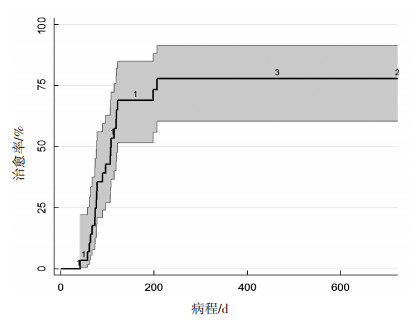Liver function damage and curability of occupational medicamentosa-like dermatitis induced by trichloroethylene: Cox regression analysis
-
+ English摘要:目的
探索肝功能损伤程度对职业性三氯乙烯药疹样皮炎(occupational medicamentosa-like dermatitis induced by trichloroethylene, OMDT)治愈率的可能影响。
方法收集2012年1月-2016年6月入院接受诊疗的所有30名OMDT病例的病程和结局资料, 用Cox回归模型分析病例住院期间检测到的血清总蛋白最低值(TPL)、白蛋白最低值(ALBL)、总胆红素最高值(TBILM)、直接胆红素最高值(DBILM)、丙氨酸氨基转移酶活性最高值(ALTM)、天门冬氨酸氨基转移酶活性最高值(ASTM)、谷氨酰转肽酶活性最高值(GGTM)、碱性磷酸酶活性最高值(ALPM)对OMDT治愈率的影响。
结果30名OMDT病例病程中位数为108 d, 截尾值占30.0%, 总体治愈率为70.0%。所研究肝功能损伤程度指标间存在共线性。通过主成分分析, 将前三个主成分代入Cox回归模型后发现, 主要反映TPL、ALBL、TBILM、DBILM变异的主成分1是影响OMDT治愈率最重要的因素(RR=0.62, P < 0.05)。Cox回归模型表达式显示, TPL和ALBL越高, TBILM、DBILM、ALTM、ASTM、GGTM、ALPM越低, 病例治愈率越高。
结论肝功能损伤程度对OMDT的治愈率有影响, 积极保护肝脏功能有助于提高病例的治愈率。
-
职业性三氯乙烯药疹样皮炎(occupational medica-mentosa- like dermatitis induced by trichloroethylene,OMDT)是少数个体接触工业和环境毒物三氯乙烯后发生的皮肤药疹样皮炎,通常伴肝功能损害。典型临床表现为皮疹、发热、肝损害和浅表淋巴结肿大[1-3]。根据不同临床表现和病情严重程度,通常分多形红斑、剥脱性皮炎、重症多形红斑、大疱性表皮坏死松解症四型[4]。尽管治疗方案经多年优化和改良,该病仍呈迁延难愈、易复发的特点[1],病例常因并发肝性脑病、严重感染及多器官功能衰竭而死亡[5-7]。由于肝损害加重是病情恶化的主要表现之一[8],通常导致病程延长和不良结局,因此我们推测肝功能损伤程度可能会影响该病的治愈率。本研究拟通过回顾性分析病例资料,验证这一假设。
1. 对象与方法
1.1 对象
对2012年1月—2016年6月进入深圳市职业病防治院接受诊疗的全部30名OMDT病例的资料进行整理。OMDT诊断由3名以上取得职业中毒诊断医师资格的专家根据《职业性三氯乙烯药疹样皮炎诊断标准》(GBZ 185-2006)[4]集体诊断。本研究符合深圳市职业病防治院伦理委员会要求,并遵守1964年及后续版《赫尔辛基宣言》和其他衍生伦理准则。
1.2 方法
1.2.1 病程和结局定义
根据截至2016年9月13日的病例资料,出现结局定义为“治愈”,至少包括下列指征:皮疹消退、皮损愈合、体温正常、临床常用肝功能指标位于正常参考值范围内,糖皮质激素停药后无复发。住院治疗、未治愈出院、转院治疗、死亡均为“截尾”。“病程”定义为从首次出现症状至出现结局或截尾的时间段,其中截尾为死亡者的病程按非死亡者中最长病程的1.5倍计算。
1.2.2 肝功能检测
分别留取30名OMDT病例住院期间做血液检查时的样本,使用Beckman DXC 800全自动生化分析仪检测样本血清中总蛋白、白蛋白、总胆红素、直接胆红素水平,以及丙氨酸氨基转移酶、天门冬氨酸氨基转移酶、谷氨酰转肽酶和碱性磷酸酶活性。病例检测次数的中位数为28次(见表 1)。根据检测指标的临床意义,取每位病人住院期间血清总蛋白、白蛋白检测结果的最低值(TPL、ALBL),总胆红素、直接胆红素、丙氨酸氨基转移酶、天门冬氨酸氨基转移酶、谷氨酰转肽酶、碱性磷酸酶检测结果的最高值(TBILM、DBILM、ALTM、ASTM、GGTM、ALPM)作为反映肝功能损伤程度的指标。
表 1 30例病例部分基本情况和肝功能指标变量 [M(Q)] 年龄/岁 24.5 (15) 病程/d 108 (130) 肝功能检查次数 28 (30) TPl(/g/L) 53.15 (7.37) ALBl(/g/L) 28.00 (7.50) TBILM/ (μmol/L) 43.50 (99.30) DBILM/ (μmol/L) 25.00 (57.90) ALTM/(U/L) 324.00 (505.50) ASTM/(U/L) 176.50 (280.75) GGTM/(U/L) 305.00 (365.25) ALPM/(U/L) 209.00 (244.75) 1.2.3 统计学分析
使用Excel 2016软件录入和整理数据,STATA 13.0软件对数据进行统计学分析和作图。计量资料经正态性检验,不符合正态分布者以中位数和四分位数间距[M(Q)]描述,符合正态分布者以( x ± s)描述。以Kaplan-meier法分析治愈率。采用Spearman秩相关分析TPL、ALBL、TBILM、DBILM、ALTM、ASTM、GGTM、ALPM间相关性,并进行共线性诊断。若分析指标间存在共线性,则进行主成分分析。提取分析指标的主成分后,采用Cox回归分析主成分对治愈率的影响,同时校正年龄、性别、民族(汉族或非汉族)、吸烟情况(是或否)、潜伏期(首次接触三氯乙烯至发病时间),最终计算分析指标影响治愈率的Cox回归模型表达式。检验水准α = 0.05。
2. 结果
2.1 基本情况
30名OMDT病例中,男性18例,占60.0%,汉族23例,占76.7%。吸烟者7例,占23.3%,无饮酒者。诊断类型:多形红斑病例最多,17例(占56.7%),其余依次为重症多形红斑7例(占23.3%)、剥脱性皮炎和大疱性表皮松解症各3例(各占10.0%)。潜伏期平均(33.93 ± 16.01)d。其余基本情况及肝功能指标见表 1。所有病例发病前均未患血液或免疫相关疾病、急慢性炎症或传染病,家族成员无患传染病或遗传病者。病例病程最短为35 d,最长722 d。
2.2 治愈率
30名病例治愈21例,治愈率为70.0%,截尾值占30.0%。治愈率随病程变化的Kaplan-Meier曲线见图 1。图示,治愈率随病程延长逐渐提高。病程超过200 d的病例有6例,其中2例死亡,2例住院治疗中,1例转院治疗,1例治愈,治愈率为16.7%。
2.3 肝功能损伤程度指标相关性分析和共线性诊断
经秩相关分析,肝功能损伤程度指标间,TPL与ALBL呈正相关(rs = 0.791,P < 0.01),TBILM与DBILM呈正相关(rs = 0.989,P < 0.01),而TPL和ALBL均与TBILM和DBILM呈负相关(rs = - 0.631、- 0.662、- 0.633、- 0.684,P均 < 0.01)。ALTM与ASTm呈正相关(rs = 0.894,P < 0.01),ALPm与GGTm、呈正相关(rs = 0.606,P < 0.01),与ALBL呈负相关(rs = - 0.468,P < 0.01)。其余指标相互间均无相关关系。
用方差膨胀因子(VIF)法对肝功能损伤程度指标的共线性进行诊断,结果显示,8个指标平均VIF值为23.66,其中TBILM和DBILM的VIF值分别为78.040、86.470,远>10,容忍度分别为0.013、0.012,均 < 0.1,提示指标间存在严重的多重共线性。
2.4 主成分分析
由于肝功能损伤程度指标间存在多重共线性,因此我们进一步做主成分分析。结果见表 2。前三个主成分特征根>1,占总变异的85.5%,故取前三个主成分进行Cox回归分析。表 3显示前三个主成分对应的正则化特征向量,其中主成分1在TPL、ALBL、TBILM、DBILM上有较大负荷,主要反映肝脏蛋白和胆红素的改变,可以表示为PC1 = -0.442 × TPL - 0.481×ALBL + 0.451 × TBILM + 0.475 × DBILM + 0.125 × ALTM + 0.117 × ASTM + 0.207 × GGTM + 0.268 × ALPm;主成分2在ALTM、ASTm上有较大负荷,主要反映肝细胞高水平酶的改变,可以表示为PC2 = 0.163 × TPL + 0.043 × ALBL - 0.201 × TBILM - 0.167 × DBILM + 0.611 × ALTM + 0.645 × ASTM + 0.263 × GGTM + 0.211 × ALPM;主成分3在GGTM、ALPM上有较大负荷,主要反映肝细胞低水平酶的改变,可以表示为PC3 = - 0.030 × TPL + 0.100 × ALBL + 0.282 × TBILM + 0.232 × DBILM + 0.341 × ALTM + 0.255 × ASTM - 0.598 × GGTM - 0.564 × ALPM。以上等式右侧变量均为标准化后的变量。
表 2 肝功能损伤程度指标间的主成分分析结果主成分 特征根 差值 方差贡献率/% 累计方差贡献率/% 1 3.461 1.510 43.3 43.3 2 1.951 0.531 24.4 67.7 3 1.420 0.901 17.8 85.5 4 0.519 0.124 6.5 92.0 5 0.395 0.224 4.9 96.9 6 0.171 0.095 2.1 99.0 7 0.076 0.070 0.9 99.9 8 0.006 0.1 100 表 3 前三个主成分对应的正则化特征向量(主成分系数/成分载荷)变量 1 2 3 TPL -0.442 0.163 -0.030 ALBL -0.481 0.043 0.100 TBILM 0.451 -0.201 0.282 DBILm 0.475 -0.167 0.232 ALTM 0.125 0.611 0.341 ASTM 0.117 0.645 0.255 GGTM 0.207 0.263 -0.598 ALPM 0.268 0.211 -0.564 2.5 肝功能损伤程度对治愈率的影响
先使用Cox全因素模型分析前三个主成分对治愈率的影响,再使用逐步回归模型验证全因素模型的结果,同时简化全因素模型的结果。使用全因素模型时,校正年龄、性别、民族、是否吸烟、发病潜伏期。全因素模型结果显示,只有主成分1影响OMDT的治愈率(RR = 0.62,P < 0.05)。逐步法Cox回归分析结果同样显示主成分1是治愈率的主要影响因素(RR = 0.66,P < 0.05)。见表 4。根据逐步回归模型和主成分1的表达式,得到Cox回归模型的表达式为:λ(t)= λ0(t)exp(0.025 2 × TPL + 0.042 0 × ALBL - 0.001 3 × TBILM - 0.003 4 × DBILM - 0.000 1 × ALTM - 0.000 1 × ASTM - 0.000 2 × GGTM - 0.000 4 × ALPM - 1.902 2)。
表 4 Cox回归模型分析相关指标对治愈率的影响变量 回归系数 标准误 Z(Wald)值 P值 RR值 RR值95%可信区间 全因素模型 年龄/岁 -0.02 0.03 -0.74 0.460 0.98 0.91 ~ 1.04 性别 1.34 0.68 1.98 0.051 3.82 0.92 ~ 14.37 民族 -0.26 0.67 -0.39 0.697 0.77 0.21 ~ 2.86 吸烟 -0.60 0.67 -0.89 0.374 0.55 0.15 ~ 2.05 潜伏期/d 0.01 0.02 0.74 0.461 1.01 0.98 ~ 1.04 主成分1 -0.48 0.18 -2.57 0.010 0.62 0.43~ 0.89 主成分2 -0.22 0.25 -0.87 0.384 0.80 0.49 ~ 1.32 主成分3 0.08 0.25 0.33 0.745 1.09 0.66 ~ 1.79 逐步回归模型 主成分1 -0.42 0.18 -2.34 0.019 0.66 0.46 ~ 0.93 3. 讨论
本研究通过分析30名OMDT病例的资料,初步探索肝功能损伤程度对治愈率的可能影响。研究发现反映肝功能损伤程度的指标TPL、ALBL、TBILM、DBILM、ALTM、ASTM、GGTM、ALPM间存在多重共线性,提取主成分进行Cox回归的结果显示,主要反映TPL、ALBL、TBILM、DBILM变异的主成分1是影响OMDT治愈率最重要的因素,其中TPL和ALBL越高,TBILM、DBILM越低,以及ALTM、ASTM、GGTM、ALPM越低,病例治愈率越高。因此,临床上积极保护肝脏功能有助于提高OMDT病例的治愈率。
OMDT与三氯乙烯急性中毒不同,多发生在接触三氯乙烯后2 ~ 5周[1, 3],这与本研究人群平均潜伏期约为34 d相符。该病常表现迁延难愈、易复发特点[1],本研究中病例非截尾病程最长是206 d。由于存在死亡病例,研究人群总治愈率低于100%。OMDT通常伴有明确的肝实质性损伤[9-10],可能发病机制包括三氯乙烯引起的化学中毒性肝损伤、Ⅳ型超敏反应和补体激活导致的免疫性肝损伤等[11-14]。实验室检查结果显示病例组血清总胆红素、直接胆红素水平,以及丙氨酸氨基转移酶、天门冬氨酸氨基转移酶、谷氨酰转肽酶和碱性磷酸酶活性显著高于对照组,而白蛋白水平低于对照组[15-16],并且肝功能指标变化与病情一致[8, 17]。在本研究中我们首次用肝功能指标的极值表示病例病程中肝脏功能受损的严重程度,分析肝功能受损程度与病例治愈率的关系。结果显示肝功能损伤程度能影响OMDT的治愈率,因此改善病例肝脏功能对治愈OMDT十分重要。
死亡病例属本研究中的特殊截尾,结局情况与其余病例存在明显差别。死亡病例一般病情危重,治愈率为零,但病程往往较短。为使死亡病例与其余病例具有相对可比性,同时又不会成为统计模型中的异常值,我们在分析中将其病程定义为非死亡者中最长病程的1.5倍。临床发现病例肝功能严重下降时应考虑到其短期死亡的风险。
本研究未发现病例年龄、性别、民族、是否吸烟、发病潜伏期长短对OMDT的治愈率的影响。医疗条件、规范水平和治疗方案等可能影响病例治愈率,但这些因素对于来自同一医疗机构的病例人群来说相对均衡,因此未在研究中作为混杂因素考虑。
虽然我们对病例住院期间所有肝功能检测结果进行汇总分析,并且临床上进行肝功能检查时病例多处于疾病急性期,但仍有可能未获得肝脏功能受损最严重时的肝功能指标值,因此回归分析结果可能存在一定偏倚。此外,由于OMDT发病率很低,本次研究人群例数相对较少,可能影响分析结果的代表性,故结论尚需要通过更大样本人群研究作进一步验证。
-
表 1 30例病例部分基本情况和肝功能指标
变量 [M(Q)] 年龄/岁 24.5 (15) 病程/d 108 (130) 肝功能检查次数 28 (30) TPl(/g/L) 53.15 (7.37) ALBl(/g/L) 28.00 (7.50) TBILM/ (μmol/L) 43.50 (99.30) DBILM/ (μmol/L) 25.00 (57.90) ALTM/(U/L) 324.00 (505.50) ASTM/(U/L) 176.50 (280.75) GGTM/(U/L) 305.00 (365.25) ALPM/(U/L) 209.00 (244.75) 表 2 肝功能损伤程度指标间的主成分分析结果
主成分 特征根 差值 方差贡献率/% 累计方差贡献率/% 1 3.461 1.510 43.3 43.3 2 1.951 0.531 24.4 67.7 3 1.420 0.901 17.8 85.5 4 0.519 0.124 6.5 92.0 5 0.395 0.224 4.9 96.9 6 0.171 0.095 2.1 99.0 7 0.076 0.070 0.9 99.9 8 0.006 0.1 100 表 3 前三个主成分对应的正则化特征向量(主成分系数/成分载荷)
变量 1 2 3 TPL -0.442 0.163 -0.030 ALBL -0.481 0.043 0.100 TBILM 0.451 -0.201 0.282 DBILm 0.475 -0.167 0.232 ALTM 0.125 0.611 0.341 ASTM 0.117 0.645 0.255 GGTM 0.207 0.263 -0.598 ALPM 0.268 0.211 -0.564 表 4 Cox回归模型分析相关指标对治愈率的影响
变量 回归系数 标准误 Z(Wald)值 P值 RR值 RR值95%可信区间 全因素模型 年龄/岁 -0.02 0.03 -0.74 0.460 0.98 0.91 ~ 1.04 性别 1.34 0.68 1.98 0.051 3.82 0.92 ~ 14.37 民族 -0.26 0.67 -0.39 0.697 0.77 0.21 ~ 2.86 吸烟 -0.60 0.67 -0.89 0.374 0.55 0.15 ~ 2.05 潜伏期/d 0.01 0.02 0.74 0.461 1.01 0.98 ~ 1.04 主成分1 -0.48 0.18 -2.57 0.010 0.62 0.43~ 0.89 主成分2 -0.22 0.25 -0.87 0.384 0.80 0.49 ~ 1.32 主成分3 0.08 0.25 0.33 0.745 1.09 0.66 ~ 1.79 逐步回归模型 主成分1 -0.42 0.18 -2.34 0.019 0.66 0.46 ~ 0.93 -
[1] 吴奇峰, 叶晓光, 陈甦生, 等.三氯乙烯药疹样皮炎研究概况[J].中国职业医学, 2010, 37(3):255-256, 258. http://d.old.wanfangdata.com.cn/Periodical/zgzyyx200605001 [2] 周丽, 徐新云, 史才枫, 等.三氯乙烯致变态反应作用及对免疫系统影响研究进展[J].中国预防医学杂志, 2010, 11(8):851-853. http://www.wanfangdata.com.cn/details/detail.do?_type=perio&id=zgyfyxzz201008030 [3] 黄永顺, 黄汉林.职业性三氯乙烯药疹样皮炎免疫损伤研究进展[J].中国职业医学, 2010, 37(2):157-159, 162. http://d.old.wanfangdata.com.cn/Periodical/zgzyyx201002024 [4] 中华人民共和国卫生部.职业性三氯乙烯药疹样皮炎诊断标准: GBZ 185-2006[S].北京: 人民卫生出版社, 2007. [5] 黄丽屏, 陈嘉斌, 曾子芳.职业性三氯乙烯药疹样皮炎8例死亡原因分析[J].岭南急诊医学杂志, 2012, 17(3):229-230. doi: 10.3969/j.issn.1671-301X.2012.03.034 [6] 司徒洁, 张健杰, 邱少宏, 等.深圳市2006-2011年三氯乙烯药疹样皮炎流行病学调查[J].职业卫生与应急救援, 2013, 31(3):119-121. http://d.old.wanfangdata.com.cn/Periodical/zywsyyjjy201303003 [7] 华明, 朱光华, 夏丽华, 等.职业性三氯乙烯药疹样皮炎死亡原因分析及干预措施[J].中华劳动卫生职业病杂志, 2010, 28(1):54-55. doi: 10.3760/cma.j.issn.1001-9391.2010.01.020 [8] 汤海燕, 张艳芳, 王佃鹏, 等.三氯乙烯药疹样皮炎病例心、肝功能与病程的关系[J].国际检验医学杂志, 2013, 34(3):307-308. doi: 10.3969/j.issn.1673-4130.2013.03.021 [9] 梁金霞.三氯乙烯中毒对肝脏功能的影响[J].实用医学杂志, 2006, 22(9):1073-1074. doi: 10.3969/j.issn.1006-5725.2006.09.045 [10] 徐新云.职业性接触三氯乙烯的皮肤损害特点及诊断探讨[J].中国公共卫生, 2004, 20(2):251-252. doi: 10.3321/j.issn:1001-0580.2004.02.074 [11] 吴奇峰, 赵娜, 李聪, 等.三氯乙烯药疹样皮炎患者淋巴细胞亚群与肝功能损害相关分析[J].职业卫生与应急救援, 2013, 31(1):1-3. [12] 吴奇峰, 赵娜, 李聪, 等.三氯乙烯药疹样皮炎患者治疗前后肝功能与外周血淋巴细胞亚群变化相关分析[J].职业卫生与应急救援, 2014, 32(6):331-334, 344. http://d.old.wanfangdata.com.cn/Periodical/zywsyyjjy201406001 [13] 越飞, 曾泽明, 陈润涛, 等.三氯乙烯药疹样皮炎患者体内补体等变化情况观察[J].中国职业医学, 2007, 34(6):448-449. doi: 10.3969/j.issn.1000-6486.2007.06.002 [14] 张家祥, 朱启星.三氯乙烯致肝脏损伤作用及其机制研究进展[J].安徽预防医学杂志, 2013, 19(5):377-380. http://www.wanfangdata.com.cn/details/detail.do?_type=perio&id=ahyfyx201305019 [15] 武南, 蒋丽娟, 黄芳.职业性接触三氯乙烯引起多器官损害的分析[J].职业与健康, 2004, 20(12):44-45. doi: 10.3969/j.issn.1004-1257.2004.12.026 [16] 张艳芳, 刘威, 刘建军, 等. 14例三氯乙烯药疹样皮炎患者肝损害病例分析[J].中国职业医学, 2011, 38(6):480-481. http://d.old.wanfangdata.com.cn/Periodical/zgzyyx201106009 [17] 刘威, 张艳芳, 张志敏, 等.三氯乙烯药疹样皮炎患者肝功能动态变化[J].中华劳动卫生职业病杂志, 2011, 29(10):790-794. doi: 10.3760/cma.j.issn.1001-9391.2011.10.022 -
期刊类型引用(2)
1. 许国庆, 洪建军, 樊静. 职业性三氯乙烯药疹样皮炎患者肝部损害的超声影像学特征及血流改变的相关性. 工业卫生与职业病. 2019(03): 217-219 .  百度学术
百度学术
2. 王乐, 姜俊杰. 职业性三氯乙烯药疹样皮炎血清总胆汁酸及补体3与肝功能损害的关系. 中国工业医学杂志. 2018(06): 425-427 .  百度学术
百度学术
其他类型引用(1)





 下载:
下载:

